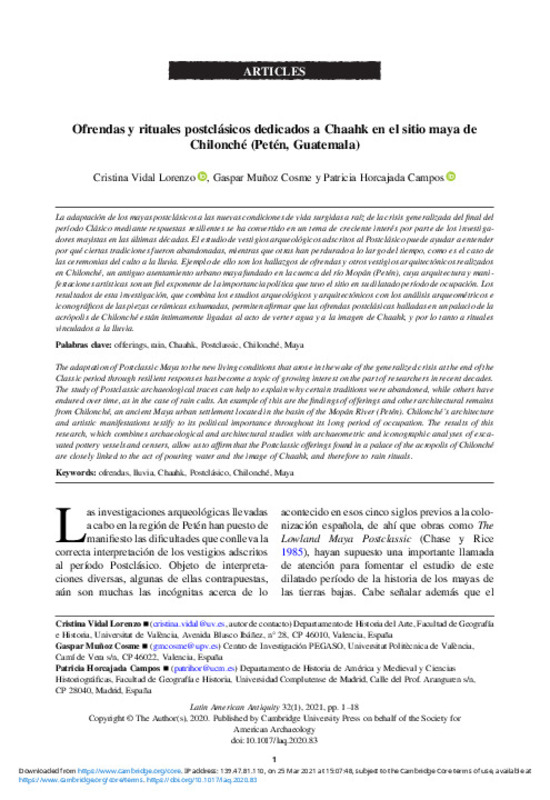Vidal Lorenzo, C.; Muñoz Cosme, G.; Horcajada Campos, P. (2021). Ofrendas y rituales postclásicos dedicados a Chaahk en el sitio maya de Chilonché (Petén, Guatemala). Latin American Antiquity. 32(1):1-18. https://doi.org/10.1017/laq.2020.83
Por favor, use este identificador para citar o enlazar este ítem: http://hdl.handle.net/10251/199476
|
Título:
|
Ofrendas y rituales postclásicos dedicados a Chaahk en el sitio maya de Chilonché (Petén, Guatemala)
|
|
Otro titulo:
|
Postclassic offerings and rituals dedicated to Chaahk at the Mayan site of Chilonche (Peten, Guatemala)
|
|
Autor:
|
Vidal Lorenzo, Cristina

 Muñoz Cosme, Gaspar
Horcajada Campos, Patricia
Muñoz Cosme, Gaspar
Horcajada Campos, Patricia
|
|
Entidad UPV:
|
Universitat Politècnica de València. Escuela Técnica Superior de Arquitectura - Escola Tècnica Superior d'Arquitectura
|
|
Fecha difusión:
|
|
|
Resumen:
|
[ES] La adaptación de los mayas postclásicos a las nuevas condiciones de vida surgidas a raíz de la crisis generalizada del final del
período Clásico mediante respuestas resilientes se ha convertido en un tema de creciente ...[+]
[ES] La adaptación de los mayas postclásicos a las nuevas condiciones de vida surgidas a raíz de la crisis generalizada del final del
período Clásico mediante respuestas resilientes se ha convertido en un tema de creciente interés por parte de los investigadores mayistas en las últimas décadas. El estudio de vestigios arqueológicos adscritos al Postclásico puede ayudar a entender
por qué ciertas tradiciones fueron abandonadas, mientras que otras han perdurado a lo largo del tiempo, como es el caso de
las ceremonias del culto a la lluvia. Ejemplo de ello son los hallazgos de ofrendas y otros vestigios arquitectónicos realizados
en Chilonché, un antiguo asentamiento urbano maya fundado en la cuenca del río Mopán (Petén), cuya arquitectura y manifestaciones artísticas son un fiel exponente de la importancia política que tuvo el sitio en su dilatado período de ocupación. Los
resultados de esta investigación, que combina los estudios arqueológicos y arquitectónicos con los análisis arqueométricos e
iconográficos de las piezas cerámicas exhumadas, permiten afirmar que las ofrendas postclásicas halladas en un palacio de la
acrópolis de Chilonché están íntimamente ligadas al acto de verter agua y a la imagen de Chaahk, y por lo tanto a rituales
vinculados a la lluvia.
[-]
[EN] The adaptation of Postclassic Maya to the new living conditions that arose in the wake of the generalized crisis at the end of the
Classic period through resilient responses has become a topic of growing interest on ...[+]
[EN] The adaptation of Postclassic Maya to the new living conditions that arose in the wake of the generalized crisis at the end of the
Classic period through resilient responses has become a topic of growing interest on the part of researchers in recent decades.
The study of Postclassic archaeological traces can help to explain why certain traditions were abandoned, while others have
endured over time, as in the case of rain cults. An example of this are the findings of offerings and other architectural remains
from Chilonché, an ancient Maya urban settlement located in the basin of the Mopán River (Petén). Chilonché¿s architecture
and artistic manifestations testify to its political importance throughout its long period of occupation. The results of this
research, which combines archaeological and architectural studies with archaeometric and iconographic analyses of excavated pottery vessels and censers, allow us to affirm that the Postclassic offerings found in a palace of the acropolis of Chilonché
are closely linked to the act of pouring water and the image of Chaahk, and therefore to rain rituals.
[-]
|
|
Palabras clave:
|
Offerings
,
Rain
,
Chaahk
,
Postclassic
,
Chilonché
,
Maya
,
Ofrendas
,
Lluvia
,
Postclásico
|
|
Derechos de uso:
|
Reserva de todos los derechos
|
|
Fuente:
|
Latin American Antiquity. (issn:
1045-6635
)
|
|
DOI:
|
10.1017/laq.2020.83
|
|
Editorial:
|
Cambridge University Press
|
|
Versión del editor:
|
https://doi.org/10.1017/laq.2020.83
|
|
Código del Proyecto:
|
info:eu-repo/grantAgreement/AEI/Plan Estatal de Investigación Científica y Técnica y de Innovación 2017-2020/PGC2018-098904-B-C21/ES/ARQUITECTURA MAYA: SISTEMAS CONSTRUCTIVOS, ESTETICA FORMAL, SIMBOLISMO Y NUEVAS TECNOLOGIAS/
...[+]
info:eu-repo/grantAgreement/AEI/Plan Estatal de Investigación Científica y Técnica y de Innovación 2017-2020/PGC2018-098904-B-C21/ES/ARQUITECTURA MAYA: SISTEMAS CONSTRUCTIVOS, ESTETICA FORMAL, SIMBOLISMO Y NUEVAS TECNOLOGIAS/
info:eu-repo/grantAgreement/Prince Claus Fund for Culture and Development//CER.2012.04309//The Maya Murals of Chilonché archaeological site/
info:eu-repo/grantAgreement/Ministerio de Educación, Cultura y deportes de España//BOE 19%2F12%2F2014//Proyecto La Blanca/
info:eu-repo/grantAgreement/AEI/Plan Estatal de Investigación Científica y Técnica y de Innovación 2017-2020/PGC2018-098904-B-C22/ES/ARTE Y ARQUITECTURA MAYA: NUEVAS TECNOLOGIAS PARA SU ESTUDIO Y CONSERVACION/
info:eu-repo/grantAgreement/UPV.CCD//AD1915//FORTALECIMIENTO COMUNITARIO PARA EL DESARROLLO SOSTENIBLE DE LA BLANCA (GUATEMALA)/
info:eu-repo/grantAgreement/CAM//2018-T2%2FHUM-11060/
info:eu-repo/grantAgreement/GVA//PROMETEO%2F2020%2F066/
info:eu-repo/grantAgreement/GVA//PROMETEO%2F2016%2F155//NUEVAS TECNOLOGÍAS APLICADAS AL PATRIMONIO CULTURAL PRECOLOMBINO: LA CIVILIZACIÓN MAYA/
[-]
|
|
Agradecimientos:
|
Los autores agradecen el patrocinio del
Ministerio de Cultura y Deporte de España a través de la
financiación obtenida por el Proyecto La Blanca y su entorno,
al Ministerio de Ciencia, Innovación y Universidades, a través ...[+]
Los autores agradecen el patrocinio del
Ministerio de Cultura y Deporte de España a través de la
financiación obtenida por el Proyecto La Blanca y su entorno,
al Ministerio de Ciencia, Innovación y Universidades, a través de la financiación de los proyectos de investigación coordinados PGC2018-098904-B-C1 y C2 sobre Arquitectura
maya, sistemas constructivos, estética formal, simbolismo y
nuevas tecnologías, a la Generalitat Valenciana a través del
Proyecto Prometeo-Mayatech 2016/155 y 2020/066, a la Fundación Palarq, a la Universidad Complutense de Madrid y
Comunidad de Madrid a través del Programa de Atracción
de Talento Investigador (2018-T2/HUM-11060) y el apoyo
del Ministerio de Cultura y Deportes de Guatemala, que
han contribuido de forma determinante a hacer posible esta
investigación.
[-]
|
|
Tipo:
|
Artículo
|









